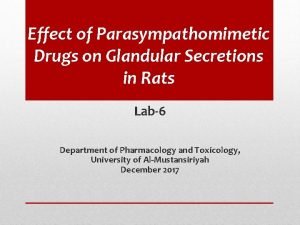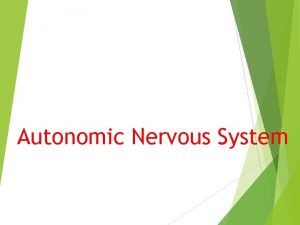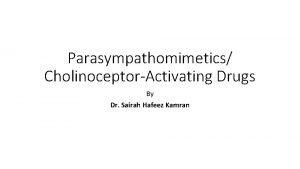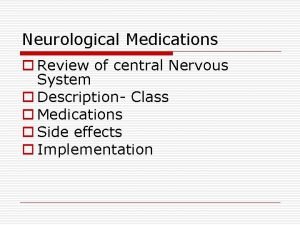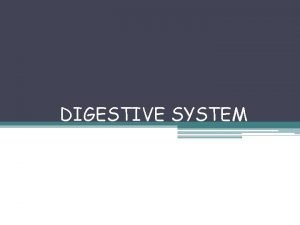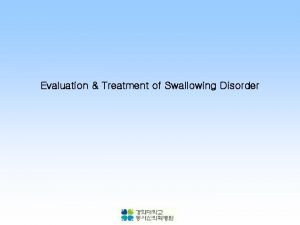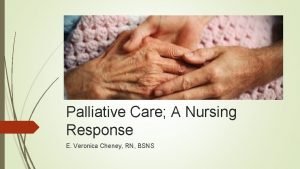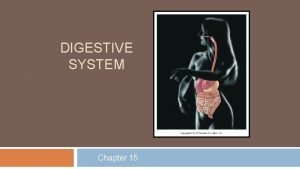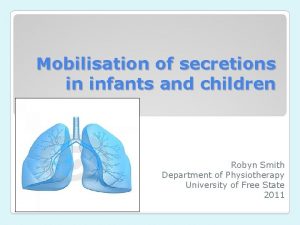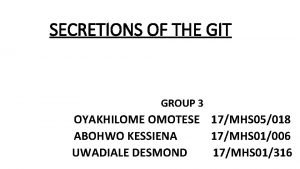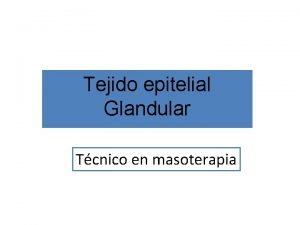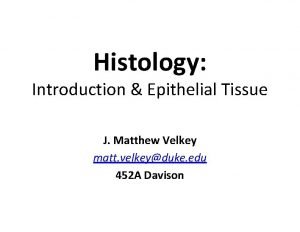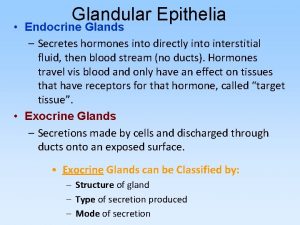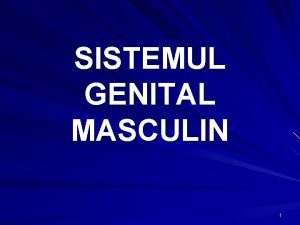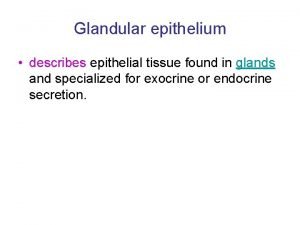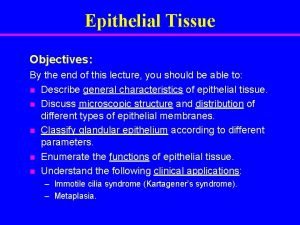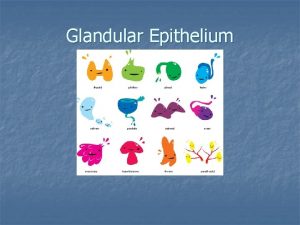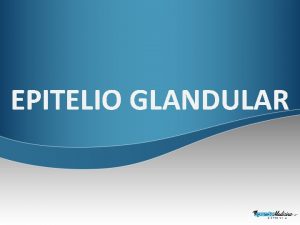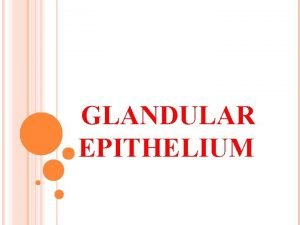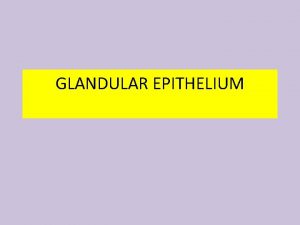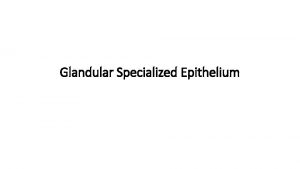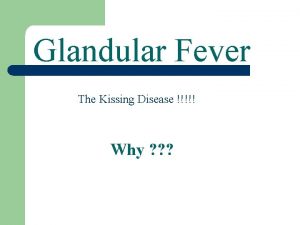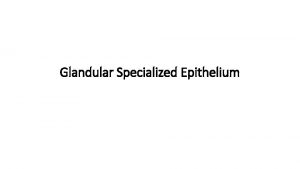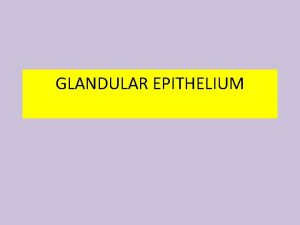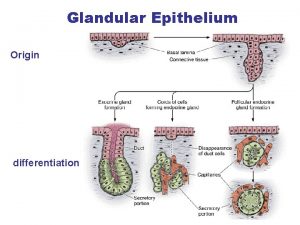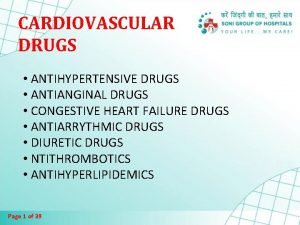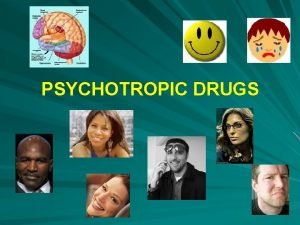Effect of Parasympathomimetic Drugs on Glandular Secretions in

















- Slides: 17

Effect of Parasympathomimetic Drugs on Glandular Secretions in Rats Lab-6 Department of Pharmacology and Toxicology, University of Al-Mustansiriyah December 2017

Nervous System • The nervous system consists of the brain, spinal cord, sensory organs, and all of the nerves that connect these organs with the rest of the body • The brain and spinal cord form the control center known as the central nervous system (CNS), where information is evaluated and decisions are made • The sensory nerves and sense organs of the peripheral nervous system (PNS) send information to CNS and regulate organs functions by efferent and afferent nerves

Autonomic Nervous System • The autonomic nervous system conveys all the outputs from the CNS to the rest of the body, except for the motor innervation of skeletal muscle • Compose of two neurons, the pre-ganglionic neuron with cell body in the CNS and the post-ganglionic neuron with cell body in the autonomic ganglia • The main processes that it regulates are: • • • Control circulation, respiration, digestion, and body temperature Contraction and relaxation of vascular and visceral smooth muscle All exocrine and certain endocrine secretions The heartbeat Energy metabolism, particularly in liver and skeletal muscle • Three main parts • sympathetic • parasympathetic • The enteric nervous system

Autonomic Nervous System • The Parasympathomimetic nervous system innervates a large number of organs. • The neurotransmitter acetylcholine (Ach) mediates the transmission of impulses from the preganglionic neurons to postganglionic neurons as well as the transmission of impulses from postganglionic nerve terminals to the effector organs. • The action of Ach at the effector organ can be mimicked by drugs like Carbachol, methacholine, or muscarine. The sites at which Ach and the Parasympathomimetics act are called Muscarinic receptors (M receptors) and they are sensitive to block by atropine

Parasympathetic N. S. • Ach is the only neurotransmitter of this system that can act on two types of receptors: Nicotinic R. and Muscarinic R.

Muscarinic Receptors • G. protein coupled receptors • Five types of these receptors (M 1 -M 5) • M 1 receptors (neural): C. N. S. , gastric parietal cells, they mediate an excitatory effect result an increase of acid secretion • M 2 receptors (cardiac); present in the heart, they exert an inhibitory effects causing bradycardia • M 3 receptors (glandular); present in the smooth muscle of G. I. T. , bronchial, bladder and exocrine glands; like sweat gland, salivary and lacrimal gland. They mediate excitatory effect which increases the glandular secretion and contraction of visceral smooth muscle • M 4 and M 5 receptors; present in C. N. S. but their functions are not fully identified

parasympathomimetic Drugs Direct-acting Indirect-acting Receptor agonists Cholinesterase inhibitors Choline esters METHACHOLINE CARBACHOL BETHACHOLINE Alkaloids PILOCARPINE Reversible PHYSOSTIGMINE NEOSTIGMINE PYRIDOSTIGMINE Irreversible Organo Phosphates

Antimuscarinic agents • Block M. R. cause an inhibition of all M. function • Have little or no action at skeletal N. M. J. or autonomic ganglia, they do not block N. R. • Reverse excessive cholinergic effects (reverse DUMBBELLS)

Antimuscarinic agents • Atropine (Hyoscyamine) • Orally absorbed , cross BBB • Competitive antagonist to Ach at all muscarinic receptors • Scopolamine: anti-motion sickness • Pirenzepine: block M. R. of the gastric parietal glands; hence it is preferred in the treatment of gastric ulcer • Ipratropine: useful in the treatment of asthma to decrease secretion & dilate obstructed air ways

Principle • Ach and parasympathomimetics stimulates the secretion of different glands in the body, like mucous, sweat, salivary and tear glands as well as secretory activity of the stomach, intestine and pancreas. • In the rat, there is a special horseshoe-shaped gland is located within the bony orbit called Harderian gland. • This gland Involves muscarinic receptors.

Aim of the experiment 1. This exp. was designed to show the stimulatory effect of cholinergic drug on glandular secretion 2. to prove that these glands are parasympathetically innervated and contain a muscarinic type of receptors.

Effect of Parasympathomimetic Drugs on Glandular Secretions in Rats The Harderian gland • The Harderian gland (or Harder's lacrimal gland) is an exocrine gland, horseshoe-shaped located within the bony orbit • Secretions from this gland include the reddish pigment porphyrin

The Harderian gland • Harderian secretions coat the eye, and drain down into the nose through the nasolacrimal duct. A rat may smear the secretions around his nose • Involves muscarinic receptors • Hypersecretion in stressed rats is often referred to as "red tears" (chromodacryorrhea) • Rats overproduce porphyrin when they are: • • Stressed, ill, or poorly fed Water deprivation Joint pain , morphine withdrawal Acetylcholine injections • After injection with acetylcholine, for example, profuse amounts of porphyrin were secreted almost immediately and overflowed the eye to stain the eyelids within minutes

The Harderian gland secretion

The Harderian gland • Cholinergic agonists such as neostigmine, carbachol, and pilocarpine caused chromodacryorrhea • Nicotine does not !! • Atropine blockes chromodacryorrhea induced by systemic administration of direct-acting cholinergic agonists !! • Thus, chromodacryorrhea appears to be a muscarinic receptorrelated event

Experimental protocol Procedure: 1. Inject 100 mg/kg of Pilocarpine I. P into a rat. 2. Examine the eyes for tears by wiping the eyelids with cotton to detect the bloody tears. Note salivation and nasal secretion…. . etc. 3. Inject another rat with 1 mg/kg of atropine I. P, wait about 15 -25 minutes, and inject the rat with Pilocarpine 100 mg/kg I. P. 4. Examine for bloody tears, salivation and nasal secretion…. etc

Results Parameters Bloody tears Salivation Urination Defecation Tremor Sk. M. contraction Pilocarpine Atropine+ Pilocarpine Effectors organ/gland Receptor
 Dumbbells antimuscarinic
Dumbbells antimuscarinic Sympathomimetic agents
Sympathomimetic agents Parasympathomimetic drugs
Parasympathomimetic drugs Parasympathetic drugs
Parasympathetic drugs Parasympathomimetic drugs
Parasympathomimetic drugs Which is the largest gland of the body
Which is the largest gland of the body Supraglottic swallowing
Supraglottic swallowing Hospice secretions medication
Hospice secretions medication Chief cells secrete
Chief cells secrete Mobilizing secretions
Mobilizing secretions Git secretions
Git secretions Glandulas exocrinas
Glandulas exocrinas Heart epithelium
Heart epithelium Glandular epithelia
Glandular epithelia Glandular organ
Glandular organ Sistemul genital masculin
Sistemul genital masculin Simple acinar gland histology
Simple acinar gland histology Epithelial tissue
Epithelial tissue
